The 1940 Ford Convertible, a timeless symbol of American automotive ingenuity, emerged during a pivotal period in history. As the world grappled with the onset of World War II, the automotive industry faced unprecedented challenges. Despite these obstacles, Ford persevered, crafting a vehicle that embodied the spirit of the era – sleek, powerful, and brimming with American pride.
The 1940 Ford Convertible was more than just a car; it was a statement of style and freedom. Its distinctive design, featuring a graceful body, a bold grille, and classic headlights, turned heads wherever it went. The convertible top, a testament to innovative engineering, allowed drivers to experience the open road in a way that was both exhilarating and elegant.
The interior, meticulously crafted with premium materials and a focus on comfort, offered a luxurious experience for both driver and passengers.
Historical Context
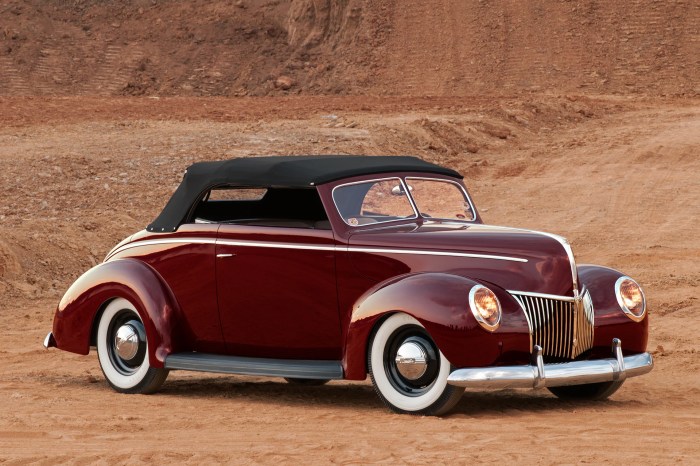
The 1940s marked a pivotal era in American automotive history, witnessing a blend of innovation, wartime necessity, and the rise of a new era of design and engineering. The decade began with the roaring twenties still fresh in the minds of consumers, characterized by opulent designs and powerful engines.
However, the outbreak of World War II in 1939 dramatically altered the landscape of the American auto industry, leading to a shift in priorities and a surge in the production of military vehicles.
The Impact of World War II on the Automobile Industry
The war effort significantly impacted the production and design of automobiles. With the nation’s resources directed towards the war, civilian vehicle production was significantly curtailed. The government mandated the use of materials like steel and rubber for military purposes, forcing automakers to adapt and innovate.
This led to the development of alternative materials and simplified designs, which would later influence the post-war automotive landscape.
Comparing the 1940 Ford Convertible to Other Popular Convertibles of the Era
The 1940 Ford Convertible was a popular choice among consumers, known for its stylish design, affordable price, and robust engine. While the Ford was a popular choice, it faced stiff competition from other popular convertibles of the era, such as:
- 1940 Chevrolet Master Deluxe Convertible:This model offered a similar level of luxury and performance to the Ford, featuring a powerful six-cylinder engine and a stylish design.
- 1940 Buick Super Convertible:Buick offered a more luxurious and powerful convertible option, featuring a powerful eight-cylinder engine and a sophisticated interior.
- 1940 Chrysler Imperial Convertible:This model was the epitome of luxury and performance, offering a powerful eight-cylinder engine and a lavish interior.
The 1940 Ford Convertible was a testament to the enduring appeal of convertibles, offering a blend of style, performance, and affordability. While the war effort significantly impacted the production and design of automobiles, the 1940 Ford Convertible stands as a reminder of the resilience and ingenuity of the American automotive industry.
The 1940 Ford Convertible, a classic of its time, embodies the spirit of the pre-war era. Its sleek lines and powerful engine made it a popular choice for those seeking a stylish and capable ride. While the 1940 Ford Convertible might be considered a predecessor to the 1951 Ford Coupe , the latter introduced a more modern aesthetic with its sweeping curves and iconic “shoebox” design.
Both models, however, remain timeless symbols of American automotive ingenuity, each capturing a distinct era in the evolution of the Ford brand.
Design and Features
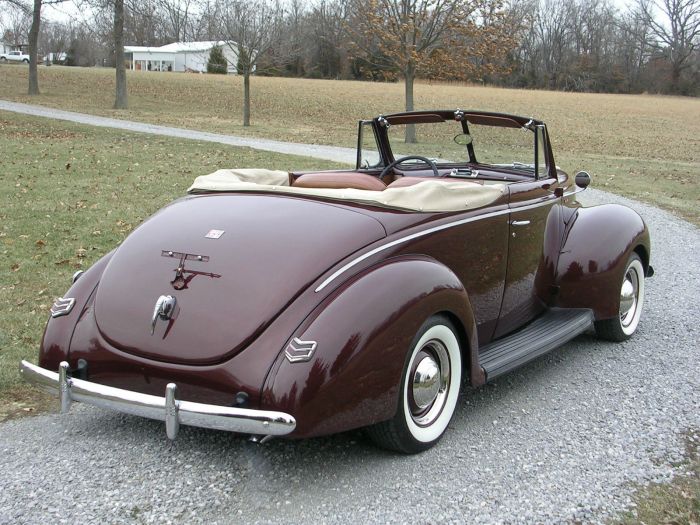
The 1940 Ford Convertible, a symbol of elegance and style, showcased a distinctive design that reflected the era’s aesthetic sensibilities. The car’s flowing lines and sophisticated features made it a popular choice among discerning drivers.
Body Style and Grille
The 1940 Ford Convertible featured a sleek and aerodynamic body style, characterized by its gracefully curved fenders and a long, flowing hood. The car’s profile was further enhanced by its distinctive grille, which consisted of a series of horizontal chrome bars that extended across the front of the vehicle.
This grille design, known as the “waterfall grille,” was a signature element of Ford’s styling during this period, and it contributed to the car’s overall sense of sophistication and elegance.
Headlights
The 1940 Ford Convertible’s headlights were integrated seamlessly into the front fenders, creating a clean and streamlined appearance. These headlights were encased in chrome bezels and featured a distinctive teardrop shape, which was a common design element in automobiles of the era.
The headlights were positioned slightly above the grille, enhancing the car’s overall visual appeal.
Convertible Top Mechanism
The convertible top mechanism was a marvel of engineering for its time. It featured a robust and reliable design that allowed the top to be easily raised and lowered. The top was constructed of durable canvas and was supported by a sturdy metal frame.
The mechanism involved a series of levers and latches that allowed the top to be folded and stowed away neatly in the trunk when not in use.
Interior Design
The interior of the 1940 Ford Convertible was a testament to comfort and craftsmanship. The car featured plush, leather-upholstered seats that were designed to provide a luxurious ride. The dashboard was characterized by its simple yet elegant layout, featuring a range of gauges and controls that were easy to access and use.
The interior materials were of high quality and were carefully selected to complement the car’s overall aesthetic.
The 1940 Ford Convertible, with its sleek lines and powerful engine, represents a golden age of American automotive design. While the 1940s were a time of change, the 1960s saw a shift towards more rugged and practical vehicles, like the 1964 Ford F100 , a workhorse pickup truck known for its durability and versatility.
The 1940 Ford Convertible, however, remains a symbol of elegance and style, capturing the spirit of a bygone era.
Performance and Engineering
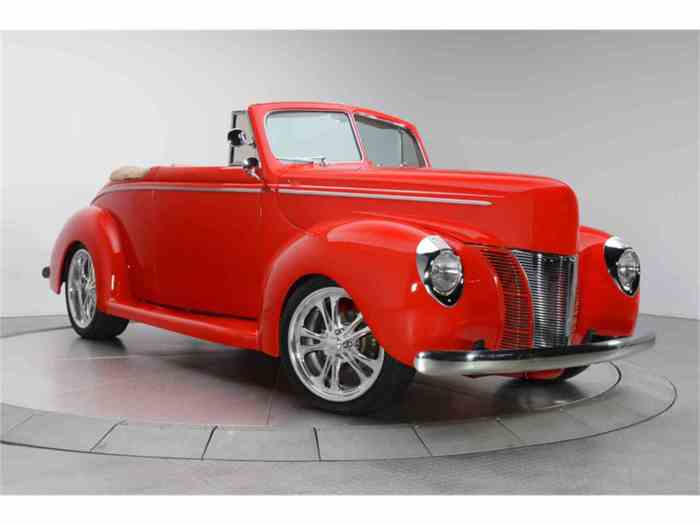
The 1940 Ford Convertible, despite its classic design, boasted a robust engine and a well-engineered chassis, providing a blend of performance and comfort that was highly regarded in its time.
Engine and Transmission Specifications
The 1940 Ford Convertible was powered by a 221 cubic inch (3.6 L) flathead V8 engine. This engine produced 85 horsepower at 3,400 RPM and 145 lb-ft of torque at 1,600 RPM. The engine was mated to a three-speed manual transmission with a column-mounted shifter.
Performance Capabilities
The 1940 Ford Convertible’s performance was adequate for its time. Its acceleration was not particularly impressive, but its top speed was around 80 mph. The car’s handling was considered good for its era, thanks to its sturdy chassis and relatively low center of gravity.
Engineering Compared to Contemporaries
The 1940 Ford Convertible’s engineering was considered to be at the forefront of its time. The flathead V8 engine was a reliable and durable powerplant that was widely used in Ford vehicles of the era. The car’s chassis was also well-designed and offered a comfortable ride.
Compared to other contemporary automobiles, the 1940 Ford Convertible offered a good balance of performance, comfort, and affordability. While other manufacturers were beginning to experiment with more advanced technologies, such as overhead valve engines, Ford remained committed to its tried-and-true flathead V8, which proved to be a winning formula for the time.
Cultural Impact and Legacy

The 1940 Ford Convertible, a symbol of American prosperity and freedom, left an indelible mark on popular culture, fashion, and automotive design. Its sleek lines, powerful engine, and open-top design captured the spirit of the era, influencing everything from fashion trends to the iconic American road trip.
Influence on Popular Culture
The 1940 Ford Convertible became a cultural icon, appearing in countless movies, television shows, and literature. Its association with glamour, freedom, and the American dream made it a popular choice for filmmakers and authors.
- In the 1940s, the 1940 Ford Convertible was featured in numerous films, including “The Philadelphia Story” (1940), starring Katharine Hepburn and Cary Grant, and “The Maltese Falcon” (1941), starring Humphrey Bogart. These films helped to solidify the car’s image as a symbol of sophistication and luxury.
- Television shows such as “I Love Lucy” and “The Adventures of Ozzie and Harriet” also featured the 1940 Ford Convertible, showcasing its appeal to a wide audience. These shows reinforced the car’s association with family, fun, and the American way of life.
- The 1940 Ford Convertible also appeared in popular literature, including novels such as “The Catcher in the Rye” by J.D. Salinger and “The Great Gatsby” by F. Scott Fitzgerald. These works helped to establish the car as a symbol of a particular era and lifestyle.
Influence on Fashion
The 1940 Ford Convertible’s sleek design and vibrant colors inspired fashion trends of the time.
The 1940 Ford Convertible, with its sleek lines and classic design, epitomized the glamour of the era. While it might not have the same flamboyant styling as its later counterpart, the 1961 Ford Sunliner , it still holds a special place in automotive history.
Both models represent a golden age of American car manufacturing, offering a glimpse into the evolution of design and performance over two decades.
- The car’s flowing lines and aerodynamic shape influenced the designs of women’s clothing, with designers incorporating similar curves and silhouettes into their creations.
- The convertible’s bold colors, such as red, blue, and green, also inspired fashion trends, with people adopting similar hues in their clothing and accessories.
Influence on Automotive Design
The 1940 Ford Convertible’s design innovations, such as its integrated headlights and streamlined bodywork, influenced subsequent automotive models.
- The car’s distinctive grille, with its horizontal bars and Ford emblem, became a signature design element for future Ford models.
- The 1940 Ford Convertible’s influence can be seen in the designs of many popular cars from the 1950s and 1960s, including the Chevrolet Corvette and the Ford Thunderbird.
Restoration and Preservation: 1940 Ford Convertible
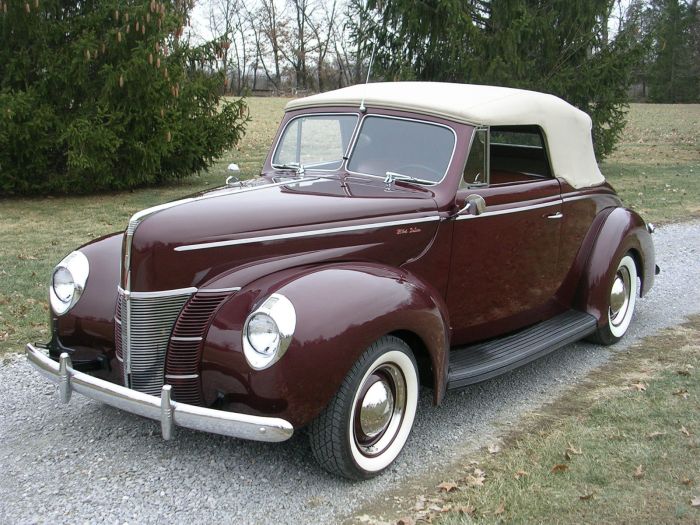
Restoring a 1940 Ford Convertible is a rewarding journey that involves meticulous attention to detail, a deep understanding of the vehicle’s history, and a passion for preserving automotive heritage. This process can be both challenging and fulfilling, requiring significant time, resources, and expertise.
Challenges and Rewards of Restoring a Classic Car
Restoring a classic car like the 1940 Ford Convertible presents unique challenges and rewards.
- Finding Original Parts:Sourcing original parts can be difficult due to their age and availability. Many parts may be rare or require extensive searching. This challenge can be overcome by utilizing specialized suppliers, online forums, and classic car parts databases.
- Technical Expertise:Restoring a classic car requires a deep understanding of its mechanical systems and construction. Many restoration projects necessitate specialized knowledge in areas such as engine rebuilding, bodywork, and paintwork. Engaging skilled professionals or seeking guidance from experienced restorers is crucial.
- Financial Investment:Restoration can be a significant financial investment, depending on the condition of the vehicle and the level of restoration desired. Planning and budgeting are essential to ensure the project remains manageable and within financial constraints.
- Time Commitment:Restoration projects require significant time and dedication. The process can take months or even years, depending on the scope of the restoration and the availability of resources.
- Sense of Achievement:Completing a classic car restoration project is a rewarding experience. The sense of accomplishment and the pride of ownership are unparalleled, knowing that you have brought a piece of automotive history back to life.
- Preserving History:Restoring a classic car helps preserve automotive history. By restoring these vehicles, we ensure that future generations can appreciate and enjoy these iconic pieces of transportation.
Key Components and Resources for Restoration
The successful restoration of a 1940 Ford Convertible relies on a combination of essential components and resources.
- Original Parts:Sourcing original parts is crucial for achieving an authentic restoration. These parts can be found through specialized suppliers, classic car parts databases, and online forums.
- Restoration Manual:A comprehensive restoration manual specific to the 1940 Ford Convertible is invaluable. These manuals provide detailed information on the vehicle’s construction, specifications, and restoration procedures.
- Tools and Equipment:A well-equipped workshop with appropriate tools and equipment is essential for performing restoration work. This includes basic hand tools, specialized tools for engine work, bodywork equipment, and painting supplies.
- Skilled Professionals:Engaging skilled professionals, such as mechanics, bodywork specialists, and painters, can significantly enhance the quality and efficiency of the restoration process. Their expertise ensures that the vehicle is restored to its original specifications and standards.
- Community and Resources:Connecting with the classic car community through online forums, clubs, and events provides access to valuable information, support, and resources. This network can offer guidance, advice, and access to specialized parts and services.
Restoration Process
Restoring a 1940 Ford Convertible typically involves a systematic process that can be divided into several stages.
- Disassembly:The first step is to carefully disassemble the vehicle, documenting the location and condition of each component. This allows for a thorough assessment of the vehicle’s condition and the identification of parts requiring restoration or replacement.
- Bodywork:The bodywork stage involves repairing any damage, rust, or imperfections. This may include straightening panels, replacing damaged sections, and preparing the body for painting.
- Paintwork:The paintwork stage involves preparing the body for painting, applying primer, and applying multiple coats of paint to achieve the desired finish. The paint should match the original color and specifications of the vehicle.
- Engine and Drivetrain:The engine and drivetrain are thoroughly inspected and restored to their original condition. This may involve rebuilding the engine, replacing worn parts, and ensuring the drivetrain operates smoothly.
- Interior:The interior is restored to its original condition, which may involve reupholstering the seats, replacing worn carpets and headliners, and restoring the dashboard and instruments.
- Assembly and Testing:Once all components have been restored, the vehicle is carefully reassembled. The final stage involves testing the vehicle to ensure that all systems are functioning correctly and that the vehicle is roadworthy.
Preservation Tips, 1940 Ford Convertible
Preserving a restored 1940 Ford Convertible requires ongoing care and attention.
- Regular Maintenance:Performing regular maintenance, such as oil changes, fluid checks, and inspections, is essential for keeping the vehicle in optimal condition.
- Storage:Storing the vehicle in a climate-controlled environment can help prevent damage from moisture, temperature fluctuations, and UV rays. Using a car cover can further protect the vehicle from dust and debris.
- Driving:Regular driving helps keep the vehicle’s mechanical systems lubricated and functioning properly. However, it’s important to avoid driving in harsh conditions that could cause damage to the vehicle.
Collector’s Value and Market

The 1940 Ford Convertible, a symbol of American automotive excellence, has become a sought-after classic car for collectors and enthusiasts worldwide. Its timeless design, historical significance, and desirability have propelled its value to impressive heights in the collector’s market.
Factors Influencing Value
The value of a classic car is influenced by a complex interplay of factors. Understanding these factors is crucial for collectors seeking to acquire or sell a 1940 Ford Convertible.
- Condition:The condition of a classic car is the most significant factor determining its value. A well-preserved and meticulously restored 1940 Ford Convertible, free from rust, damage, and modifications, commands a premium price.
- Rarity:Rarity plays a crucial role in determining the value of a classic car. The 1940 Ford Convertible, with its limited production run, is already considered a rare car. However, specific variations, such as unique color combinations or factory-installed options, can further increase its value.
- Originality:Classic cars with original parts and components are highly prized by collectors. A 1940 Ford Convertible that retains its original engine, transmission, and interior, is considered more desirable and valuable than one that has undergone significant modifications.
- Documentation:Comprehensive documentation, such as the original owner’s manual, service records, and historical information, adds to the authenticity and value of a classic car.
- Market Demand:The demand for a particular classic car model fluctuates based on factors such as current trends, media exposure, and economic conditions. A 1940 Ford Convertible that enjoys strong market demand will command a higher price.
Investment Potential
Investing in classic cars, including the 1940 Ford Convertible, can be a rewarding experience. However, it is essential to understand that classic cars are not traditional investments and carry inherent risks.
Classic cars are not a guaranteed path to wealth, but they can be a source of enjoyment and potential appreciation.
- Appreciation Potential:Well-maintained and sought-after classic cars, like the 1940 Ford Convertible, have historically demonstrated appreciation in value. This appreciation is influenced by factors such as rarity, condition, and market demand.
- Market Volatility:The classic car market, like any other market, is subject to fluctuations. Economic downturns, changes in consumer preferences, and other factors can impact the value of classic cars.
- Maintenance Costs:Owning a classic car involves significant maintenance costs. Regular servicing, repairs, and restoration work can be expensive.
- Storage and Insurance:Classic cars require specialized storage and insurance. These costs can add to the overall expense of owning a 1940 Ford Convertible.
Wrap-Up
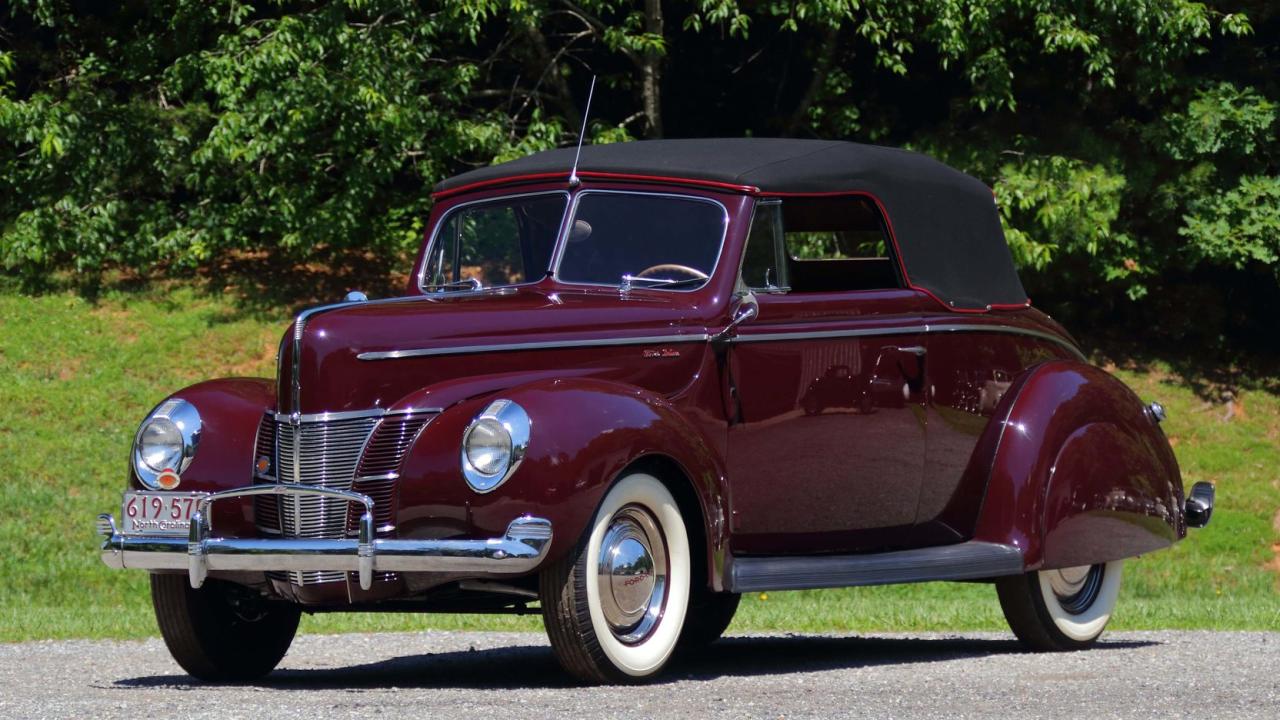
The 1940 Ford Convertible continues to captivate enthusiasts today, its legacy solidified by its enduring appeal and historical significance. Its sleek design, powerful performance, and enduring cultural impact have cemented its place as a true American icon. Whether gracing the silver screen or cruising down a modern-day highway, the 1940 Ford Convertible remains a testament to the enduring allure of classic American automobiles.